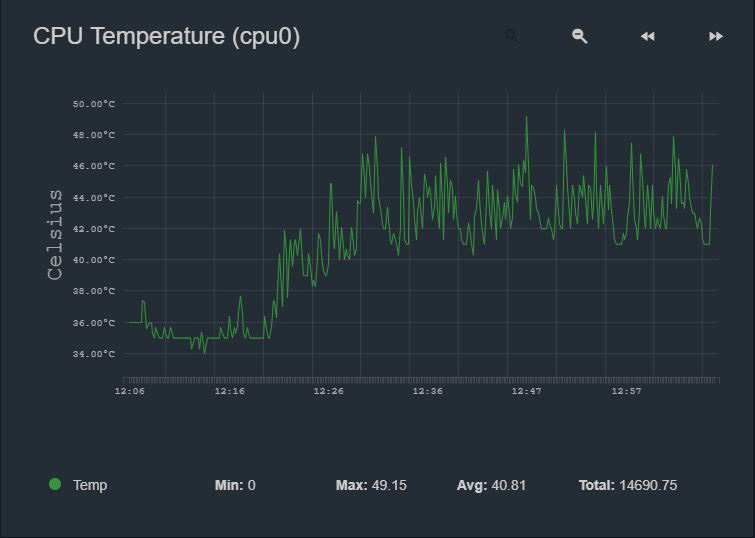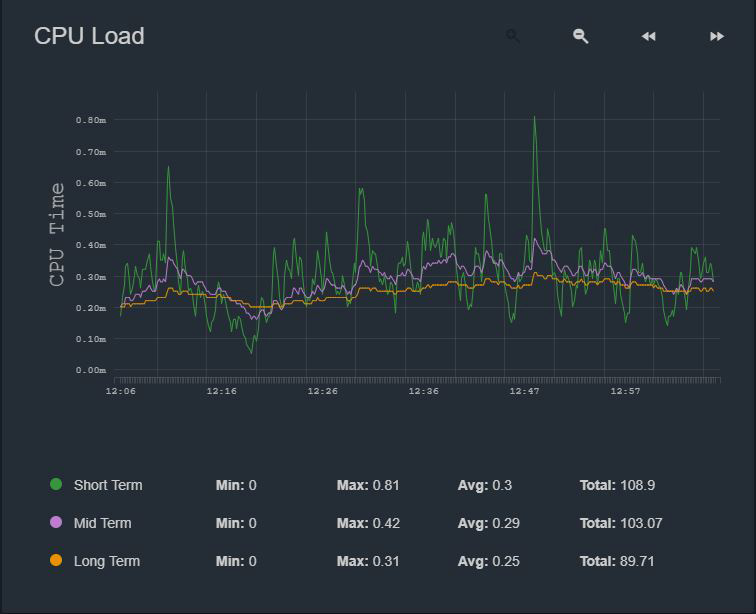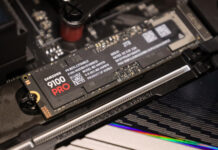SilverStone CS280 NAS Power Use and System Stats
Given the component install, we saw an idle power use of 71w and a full load of 126watts, this is considerably higher than most consumer NAS units we have tested, the SilverStone CS280 offers higher-end components though so that is what we would expect.
The Intel Xeon Gold 6134 does run rather warm, we did have hyper-threading turned off. Throughout all of our tested, we only heard the CPU fan spool up several times, overall the system makes little noise and compares to the consumer/SMB NAS units we have tested.

Typical hard drive temperatures ran around 45 Celsius. Again, these are 15K rpm SAS drives which will get warmer than just about any SATA SSD you would put in the chassis.
The FreeNAS CPU load screen shows a typical encrypted run, which again hardly stresses the Gold 6134.

Typical CPU Usage ran around 10 to 20 percent so there is plenty of headroom with this system.
One benefit of the components we used is a large amount of memory we installed at 32GB. Typically we saw the system use up to 26GB of RAM during test runs, FreeNAS will use available free memory for ZFS data cache which greatly helps in performance.
Final Words
The SilverStone CS280 is an excellent case with high build quality. SilverStone generally does a great job here. The CS280 disassembles for building fairly easy which greatly aids in installation. When we went to build the SilverStone CS280 NAS, there were still a few “gotchas.”
Important items to consider are the power supply and mini-SAS HD cables. The PSU must be of SFX form factor to allow space to the SATA backplane. Next, are the cables. Standard mini-SAS HD cables will work but for only the first 4 ports, angled cables work perfect and allow the full use of the backplane when one is using a larger PSU like we were. At the same time, there are only so many SFX PSUs on the market, and the ST-SX500-G may be the best option for a lot of people.
We pushed the configuration with the motherboard. The ASRock Rack EPC621D41-2M setup was in the lab and ready to go so we used this. If M.2 SSDs for cache drives is important then this would handle that with great results. Using all eight drive bays forced us into using the LSI-SAS9300-8i controller as the EPC621D41-2M has only one mini-SAS with four ports. That meant no 10GbE for us. With different configurations, one could use a 10GbE/ 25GbE network card and onboard SATA for four drives total, but that would waste drive bays. Better still, one could use a different motherboard with the ability to have 8x drives and 10GbE onboard. Admittedly, we pushed this build further than we would likely do for our own systems.
With all that said, the SilverStone CS280 case can be configured in many different ways with motherboards, CPUs, and RAM to reduce power use and heat. The SilverStone CS280 build quality and configuration meant that we were able to push this configuration to use Xeon Gold along with 15K rpm SAS. With the parts we used in this build they simply maxed out the 1GbE network connection and storage performance that no other consumer NAS could do.
For capacity NAS units, 3.5″ chassis are still the way to go. If you want something small and fast, 2.5″ full of SATA or SAS SSDs is a great option.
At the time of writing the SilverStone CS280 has a street price of around $179.99 which is a good price for a high-quality small form factor case such as the CS280.




LOL… love the overkill! A nice Xeon D system with enough onboard SATA ports & 10 GbE… yeah. I realized SuperMicro offers 2 different PCIe- (2 or 4) NVMe drive cards… that or a video card would be a crazy converged widget. Or… a case like this that could take a FlexATX and you’d get 2 PCIe slots.
If I was ready to abandon 3.5″ drives/jump fully on the 2.5″ drive bandwagon this could be great. At this point I’m not there and I’m still waiting for their latest 8x 3.5″ drive case (CS 381 or something!?) to become available. That one can allegedly take a FlexATX board too…..
> Cable clearance is very tight but everything fits. The fully modular power supply is almost a must here.
This sentence on page 2 followed by a picture that explains very well that fully modular PSUs here are almost a no-go here. It is like the person arranging the pictures for this review strongly disagrees with the opinion of the reviewer here. LOL, it’s just hilarious. Now, look at the picture again and recall what the reviewer wrote on page 1:
> The power caps can be bent around very easily so care should be taken to not break them.
Now look at the clearance between those caps and the modular PSU cables at the photo. LOL, again…
Such compact cases with little space “behind” the PSU are a prime example of the one disadvantage modular PSUs have in such space-constrainted situations: A need for additional space for those plugs there.
A well-chosen non-modular PSU would have avoided modular PSU cables (almost) rubbing shoulders with the SATA connectors and buffer caps. Also note how the SATA backplane is aiding the (potential) use of a non-modular PSU, as it has three of the SATA ports relocated from the area where normally the cables of a non-modular PSU would exit the PSU case.
I am just on page 2 of the review and i already see myself starting to question the reviewers experience with regard to assembling systems and how much thought went into writing the review. Hmm, it almost feels like this review did not just review a Silverstone case, but needed to plug (pun intended) yet another Silverstone product series…
There’s enough room for modular just barely from the pics. I read that part as without modular you’d have too many cables inside so fully modular means you can cut down on cables? That’s reasonable to me. If modular didn’t fit, that’d be a problem. If it fits and cuts down cable clutter, that’s what I’d want.
Great review and build. Counting on STH to always do something over the top like this. Ya’ll rock.
And I’d do modular seeing this too.
@JaredD, you would buy a PSU fitting for the system, not buy a PSU with the mosts cables, no? Why would you think a non-modular PSU has to come with too many cables? There is no logic to this thought.
It fits doesn’t it? I’m totally perplexed. These guys have something that’s actually working and you’re set on some theoretical non-modular PSU that you don’t know if it would actually work. For me, I like examples with pictures of something working. They’ve shown it. You haven’t.
Ah, i see. A believer. “Some theoretical …”, “that you don’t know if it…” “they have shown it”. Well, i guess there is no point continuing…
nice review, but dissapoitting computer case.
2,5 inch hdd space? and….8 sata ports?
why not 3,5 inch hdd? and why not sff-8087 ports?
I had this case and unless they updated it there is really no airflow over the drives. I had 8 4tb 2.5″ spinners in this case and the ones towards the center were getting uncomfortably hot (don’t remember the temp, it’s been a while).
I have this chassis and I’m going to replace the motherboard as I’ve just used a consumer Asrock Z370m-ITX/AC and want one of those Supermicro boards. It really requires some dedication to build this system and one thing that could massively improve the situation for me, is if they could accept two mini-sas connectors and do the breakout on the backplane. But it really is a very nice chassis.
By the time I’m done filling it with 4TB HDDs, I think 4TB SATA SSDs should have dropped to an acceptable level and with 30TB 2.5″ SSDs being a reality already, I think there’s plenty of room for future growth.
Great article!
I’m surprised there’s any airflow over the drives once the front door is closed.
Why isn’t it mesh?
Bán nhà mặt phố Hoàng Hoa Thám, Hà đông, 98
mét vuông, 4 lầu, 9.6 tỷ.
You need to add the extra funs above the drive cage, otherwise the drives will heat up a lot, i have this cage and my drives (without extra fun) went over 70 degree celsius, i bought Arctic 10 Port PWM Fan Hub with SATA Power, 2x P8 PWM MAX, 82 mm x 82 mm, cut the hole in case above the drive cage and installed the funs sucking the air out of the cage, temp for the drives went down to 35-45 degree celisus, maybe some extra drilled holes in the sides of drive cage could lower the temp for side drives as well. I use 1TB 10RPM Dell brandes Savio drives.